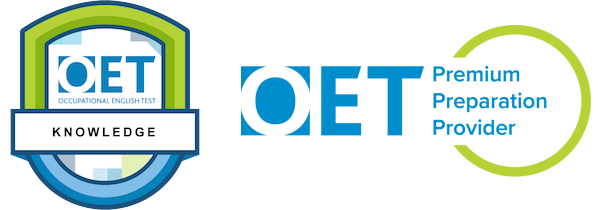
YES!!! The updated Occupational English Test has already come into effect on the 9th of September 2018.
As soon as we say OET, the healthcare sector is what comes to mind first.
Any healthcare professional aspiring to work /study in the healthcare profession as delineated in a bullet form below in the UK, Ireland, Australia, New Zealand, Ukraine, Dubai, Singapore or Namibia, needs to take an English proficiency test…..and OET is an English language Proficiency Test designed specifically for healthcare professionals!
OET has been developed specifically for 12 healthcare professions:
- Nursing
- Medicine
- Dentistry
- Physiotherapy
- Dietetics
- Occupational Therapy
- Optometry
- Pharmacy
- Podiatry
- Radiography
- Speech Pathology and
- Veterinary Science.
The OET test, facilitates the healthcare professionals, worldwide, to prove that they have the right level of English and thus have a command over the kind of language they will need for a day-to-day work scenario in their respective professions.
The main attractions to OET-2, however, remain: its wide recognition as proof of English proficiency in the healthcare sector; its use of real healthcare scenarios to make the healthcare professional feel at ease and more confident on the test day and last but not the least; OET-2 also helps, even more so than OET1 to develop language skills that are essential for success in a career in the healthcare sector in the changing modern era.
It’s easy to prepare for the test with Acumen;- our OET Preparation Portal is worth checking out!
Let us consider a little more in-depth information on how the Occupational English Test OET is based on the typical workplace scenarios in these varying healthcare professions.
Listing them individually in the order of preferential popularity, the 4 professions wherein the students preferentially opt to answer OET are:
- Occupational English Test for Nursing
- Occupational English Test for Medicine
- Occupational English Test for Dentistry
- Occupational English Test for Physiotherapy.
OET covers all the four language skills with an emphasis on communication in a healthcare environment.
Follow the Acumen OET blog for stories about other candidates like you appearing for OET and connect with them on a personal level on social media to remove your doubts and get your queries answered first hand.
Not many changes are made in the Spoken or Written modules, in OET-2 but both, the Listening and Reading modules have been changed considerably, both in terms of pattern, and types of questions as well as the assessment criteria. Thus, ‘understanding’ the extracts has now become the ‘Key’ to the assessment rubrics.
However, though the Listening module or subtest shows a change in pattern from the original OET-1 to the present day OET-2 the listening subtest is of approximately 40 minutes and it has the same content for all the above 12 healthcare professions involving the understanding of a range of health-related ‘spoken’ materials such as patient consultations and lectures.
Similarly, the Reading module, too of OET-2 is different from the original OET-1 and the sub-test is of 60 minutes, but again, the subtest has the same content for all healthcare professions. This, however, involves reading and understanding of different types of text on health-related subjects.
The details of the change in pattern and assessment criteria of both of these above; -the reading subtest and the listening subtest structures have been elaborated elsewhere in the blog.
The Writing module, on the other hand, is of only 45 minutes and is specific to the healthcare profession being tested. The very profession-specific, writing subtest structure of the writing subtest task, generally involves those scenarios that are based on the typical workplace situation and demands of that specific healthcare sector, so, – a nurse does the task for nursing, a dentist does the task for dentistry, and so on.
For example, in the letter writing task, it is usually a referral letter, (e.g. for the Occupational English Test for Medicine, Dentistry or Physiotherapy.) but sometimes, (especially for certain professions like nursing) a different type of letter is given as a part of the writing subtest:- e.g. a letter of transfer or discharge, or a letter to advise or inform a patient, a caregiver/taker, or a group.
Along with the task instructions, one also receives what OET calls “stimulus material” (case notes and/or other related documentation) which includes information that has to be used as a reference to construct the letter and use in one’s response. In order to perform to the best of one’s ability on the Writing task, it is important to understand the task and the case notes and then plan a response. The five minutes of reading time at the start of the Writing sub-test are given to you, solely for this purpose.
The writing sub-test tasks are designed so that the remaining 40 minutes is enough time for you to write a response of the required length and to check over what you have written. You can consult the task and the case notes at any point during the 40 minutes allocated for writing, not just during the reading time.
A minimum of 2 trained Assessors independently mark the candidate’s performance on the Writing sub-test and neither knows what scores the other assessor has given, or what scores have been achieved by the candidate on any of the other sub-tests. The performance is scored against the following criteria and receives a band score for each criterion:
- Overall Task Fulfilment
- Appropriateness of Language
- Comprehension of Stimulus
- Linguistic Features (grammar and cohesion)
- Presentation Features (spelling, punctuation, layout)
Spelling mistakes and punctuation errors are some important aspects included under Presentation Features; so, any spelling mistakes will be taken into account and affect your final score for Presentation Features.
There is no automatic penalty for writing over or under the word range for the task (180 – 200 words) unlike in the other proficiency exams like IELTS, PTE, etc. However, each task has been tailor-made to be achieved within a particular word range.
If there is significantly more matter, it is likely that irrelevant material has been included or the letter is not well organized. If the words are less, on the other hand, the task may have been misunderstood or some vital information of the task and/or the case notes may have been missed. In either case, the scores for the assessment criteria for writing will reflect these weaknesses and hence affect the scores.
The Speaking module too is approximate of 20 minutes and is again specific to the particular healthcare profession being tested. The speaking test structure of the speaking task is based on role plays in a typical workplace situation, specific, to a particular profession.
Mostly, two role-plays will have to be enacted in a private room. The candidate takes on the role in the professional capacity (as a healthcare professional) while the assessor/examiner plays a patient or client, or sometimes even a relative or caregiver.
The Speaking sub-test structure
In each Speaking test task, first, the identity and profession of the candidate are first checked by the assessor and a short warm-up conversation about the professional background is conducted before the role plays.
Role-plays
The 2 role-plays are introduced one by one and three minutes are given towards preparing for each. The role-plays themselves are for about a five-minute duration each. The information for each role-play will be received on a card that can be retained by the candidate throughout the enactment of the role play. The card has all the details that explain the situation and enumerates all the assessment criteria as well as all that the candidate is required to do. The candidate is permitted to write notes on the card and also ask questions about the content of the role-play or inquiries on how the to role-play actually works, during the 3 minute preparation time.
The role-plays are based on typical, healthcare, profession specific, workplace situations and reflect the demands made on a health professional in those situations. The assessor follows a script so that the Speaking test structure is similar for each candidate. Different role-plays are used for different candidates during the same test administration.
The Speaking test is recorded and this audio recording is assessed and the sub-test is marked independently by a minimum of two trained OET Assessors. Their judgments are targeted and specific, of the candidates’ ability in spoken English. It must be remembered here that OET is a test of English-language skills, not a test of professional knowledge. Neither Assessor knows what scores the other has given, or what scores have been achieved on any of the other sub-tests. In fact, the test day assessor plays no role in the assessment of your performance.
Familiarity with the assessment criteria and attention to the details of the specific role-play task give the candidate a better band score whereas candidates who use memorized material or rely on techniques that worked in other circumstances tend to fall short of their full potential in the test, demonstrating a lack of ability in the key areas.
The role-play situations allow the candidate to take a professional role and demonstrate the ability to deal with common professional situations, which may include elements of tension that are a normal part of the real-life context: for example, anxious or angry patients, patients who misunderstand their situation, limited time in which to explain instructions.
Performance is then scored against the following criteria and each criterion receives a band score:
- Intelligibility (pronunciation, enunciation, intonation, stress, rhythm, and accent)
Fluency (rate and flow of speech) - Appropriateness of Language (including the use of tone, suitable to the situation and for the patient)
- Resources of Grammar and Expression (including range and accuracy of language, ability to paraphrase & to maintain cohesion in longer utterances)
- Relationship-building (demonstrating an attentive and respectful attitude, and showing empathy for the patient’s predicament)
- Understanding and incorporating the patient’s perspective.
- Providing structure.
- Information-gathering (including appropriate use of open or closed questions, and summarising information to encourage correct, further information)
- Information-giving (giving information in appropriate-sized chunks, checking comprehension and need for more elaborate further information).
It is usual for a role-play to come to a natural end at around the 5-minute mark. If this does not happen, the assessor will clearly signal that it is time to conclude the role-play. There is no penalty for not completing all the elements on the role card. However, the more elements of the role-play you cover, the more evidence you are likely to give of your ability to communicate in spoken English.
You should aim to achieve the highest possible grade for each criterion; so, grade B mean scores of 5 out of 6 on each linguistic criteria.
This and find out much, much more to put all your fears to rest, with Acumen: it has the best-trained faculty to coach you in the new format for a better performance.
0 Comments
Leave a reply
You must be logged in to post a comment.






